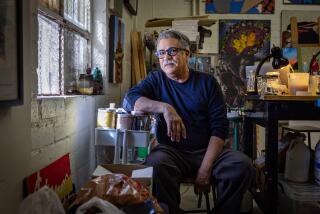Frederick Hammersley dies at 90; acclaimed painter
Frederick Hammersley, a critically acclaimed painter who rose to fame in 1959 as one of four Los Angeles-based Abstract Classicists and spent the next 50 years bringing an intuitive, personal touch to hard-edge abstraction, has died. He was 90.
The artist died peacefully Sunday in Albuquerque, where he had lived and worked since 1968, said his sister, Susie H. Stone.
His place in art history was secured by “Four Abstract Classicists,” a 1959 traveling exhibition organized by the Los Angeles County Museum of Art featuring paintings by Hammersley, Lorser Feitelson, John McLaughlin and Karl Benjamin. The exhibition, which also appeared at the San Francisco Museum of Modern Art, the Institute of Contemporary Art in London and Queen’s University in Belfast, Ireland, offered the L.A. artists’ cool, crisp abstractions as a striking alternative to the reigning, highly emotional Abstract Expressionism.
The label stuck to Hammersley, but as his career evolved, his work defied confinement.
“Hard-edge is often very hard to take, coming to it cold -- or, even to the practiced eye,” he wrote in an exhibition catalog.
Reviewing a retrospective of his work for The Times in 2000, critic Leah Ollman observed: “Hammersley takes several steps toward making his work more accessible, less aloof. For one, he uses titles as invitations in, catalysts to closer looking. . . . Another savvy and refreshing move Hammersley makes is to counter the clean, impersonal precision of hard-edge painting with the amusing presence of his own personality, his own hand. . . . Most brilliantly of all, he contains each of his works within wooden frames that he makes by fingerprint-like depressions. . . . They nudge the works into a stylistic no-man’s-land, which is all the richer for its internal contradictions and resistance to cut-and-dried uniformity.”
All of his work exudes a joy of painting freely, but he devised three categories for his art. “Hunch” paintings are unplanned works that begin with a shape and continue with intuitive additions. “Geometrics” are rhythmic orchestrations of geometric shapes. “Organics” are composed of curving forms.
Hammersley was born Jan. 5, 1919, in Salt Lake City, where his father worked for the U.S. Department of the Interior. His job took the family to Idaho, back to Salt Lake City and then to San Francisco, where Frederick took his first art classes. After two years of undergraduate work at the University of Idaho, he plunged into art, studying at Chouinard Art Institute in Los Angeles.
His education was interrupted by military service from 1942 to 1946. But as an Army sergeant, he was stationed in Paris, then the center of the art world.
“That was marvelous for me, really,” Hammersley told an interviewer in 1999. “One day, the USO posted a sign offering trips to Picasso’s studio.” He went to the studio with three other GIs, visited Picasso four more times and, as the war wound down, took courses at the Ecole des Beaux Arts in Paris.
When Hammersley returned home, the GI Bill of Rights subsidized a year of study at Chouinard, now California Institute of the Arts, and three years at Los Angeles’ Jepson Art Institute, now defunct.
He made his living as an art professor in Southern California for about 20 years, teaching at Chouinard, Jepson and Pomona College in Claremont. In 1968 he accepted a teaching position at the University of New Mexico and moved to Albuquerque. He resigned in 1971 to devote himself to painting.
Hammersley’s productivity and visibility waxed and waned over the years, but he compiled an extensive list of exhibitions and enjoyed a revival of interest in his work in his last decade. In Southern California, L.A. Louver Gallery in Venice showed his paintings in 1999 and 2002; the Laguna Art Museum in 2000 presented a traveling exhibition organized by the Museum of Fine Arts in Santa Fe; and the Pomona College Museum of Art staged a retrospective in 2007.
His work is in the collections of museums across the country, including LACMA, the San Francisco Museum of Modern Art, the Santa Barbara Museum of Art, the Albright-Knox Art Gallery in Buffalo, N.Y., and the Corcoran Gallery of Art in Washington, D.C.
Hammersley is survived by his sister, who lives in Santa Fe. A memorial service will be held June 20 at 1 p.m. at the University of New Mexico Alumni Chapel in Albuquerque.
More to Read
The biggest entertainment stories
Get our big stories about Hollywood, film, television, music, arts, culture and more right in your inbox as soon as they publish.
You may occasionally receive promotional content from the Los Angeles Times.






